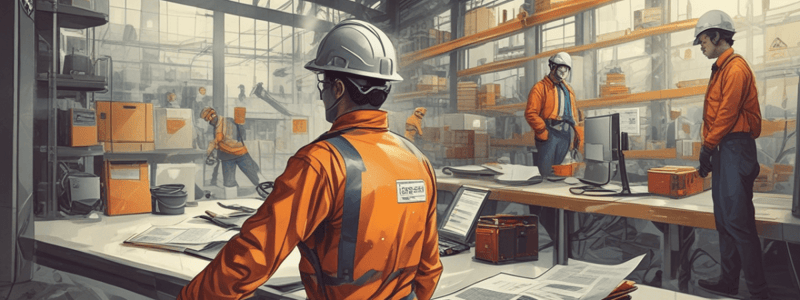Podcast
Questions and Answers
What is a critical injury according to the guidelines?
What is a critical injury according to the guidelines?
- An injury that requires a few days of rest
- An injury that requires medical attention but is not serious
- An injury that occurs while on duty but is not work-related
- An injury that places life in jeopardy or produces unconsciousness (correct)
Which of the following is NOT a critical injury?
Which of the following is NOT a critical injury?
- Loss of sight in an eye
- Amputation of a hand
- Fracture of a finger (correct)
- Fracture of a leg
Who should be notified first in the event of a critical injury?
Who should be notified first in the event of a critical injury?
- The Officer in Charge
- The On-duty Platoon Chief
- The TFS Communication Centre (correct)
- The JHSC Labour Co-Chair
What information should be provided to the Communication Centre?
What information should be provided to the Communication Centre?
Who should the Communication Centre notify immediately after a critical injury?
Who should the Communication Centre notify immediately after a critical injury?
What is the responsibility of the Platoon Chief after a critical injury?
What is the responsibility of the Platoon Chief after a critical injury?
Which of the following is an example of a critical injury?
Which of the following is an example of a critical injury?
What should be used to notify the Communication Centre, if possible?
What should be used to notify the Communication Centre, if possible?
Who should be contacted after consulting with the Co-Chairs in the event of a critical injury?
Who should be contacted after consulting with the Co-Chairs in the event of a critical injury?
Who is responsible for ensuring the incident/discovery area is protected from access until transferred to the appropriate authority?
Who is responsible for ensuring the incident/discovery area is protected from access until transferred to the appropriate authority?
When can the scene be disturbed?
When can the scene be disturbed?
What should be done before moving the equipment at the scene?
What should be done before moving the equipment at the scene?
Who should the Platoon Chief or Division Chief consult with before releasing the scene?
Who should the Platoon Chief or Division Chief consult with before releasing the scene?
What should be included in the sketch of the accident scene?
What should be included in the sketch of the accident scene?
Who should the Platoon Chief notify once the Communications Centre has notified the necessary parties?
Who should the Platoon Chief notify once the Communications Centre has notified the necessary parties?
What should be done with the personnel involved in the critical injury's PPE and SCBA?
What should be done with the personnel involved in the critical injury's PPE and SCBA?
Who should be notified about the location of the held equipment?
Who should be notified about the location of the held equipment?
Who is responsible for forwarding the critical injury report to the Ministry of Labour?
Who is responsible for forwarding the critical injury report to the Ministry of Labour?
Flashcards are hidden until you start studying
Study Notes
Critical Injury Definition
- A critical injury is an injury that places life in jeopardy, produces unconsciousness, or results in substantial loss of blood, fracture, amputation, or burns to a major portion of the body.
- It also includes injuries that result in the loss of sight in an eye, or certain underlying medical conditions that cause employees to lose consciousness while at work.
Critical Injury Notification
- The Officer in Charge shall notify the TFS Communication Centre via telephone if possible, providing the following information:
- Name of the injured individual
- Assigned apparatus at time of injury
- Platoon
- Address where injury occurred
- Time of injury
- Supervising Officer
- Number of Toronto Paramedic Services unit
- Name and badge number of Police Officer
- Name of destination hospital if applicable
- Contact names and telephone numbers
Communication Centre Responsibilities
- The Communication Centre shall immediately notify the following:
- On-duty Platoon Chief or Division Chief (Support Divisions)
- JHSC Labour Co-Chair/member or designate
- JHSC Management Co-Chair/member or designate
- On Call Senior Officer
Platoon Chief Responsibilities
- The Platoon Chief shall:
- Confirm that the incident is a critical injury
- Ensure that Communications have contacted the required personnel
- Contact the Ministry of Labour (MOL) after consulting with Co-Chairs
- Determine if the MOL will be attending the scene
- Inform the Incident Commander or their designate if the MOL will be attending and releasing the scene
- Investigate the incident with the Local 3888 representative or designate
- Notify Occupational Health & Safety Manager & Consultant in the People, Equity & Human Rights Division (PEHR)
- Compile all requisite information for a critical injury report
- Forward this information to the Management Co-Chair or their designate for review and submission to the MOL
Safety and Scene Preservation
- The Incident Commander or Officer in Charge is responsible for ensuring the incident/discovery area is protected/restricted from access until transferred to the appropriate authority at the scene.
- The scene may be disturbed only for saving life, relieving human suffering, maintaining an essential public service, or preventing unnecessary damage to equipment or property.
- The scene can only be released by a Ministry of Labour Inspector.
- The Platoon Chief or designate will be responsible for preserving the scene until formally released by the MOL.
Disturbing the Accident Scene
- If the scene must be disturbed, photographs should be taken or the scene should be sketched before it is disturbed.
- Mark locations with a piece of chalk when equipment is moved.
- If not possible, the Officer(s)/Supervisor(s) should make a mental note about where everything relating to the accident was found.
- After the casualty has been treated, sketch the layout and include information about the accident, including positions of equipment and patient.
Equipment and Personnel
- All personnel involved in the critical injury shall have their PPE including SCBA bagged and held.
- The equipment shall not be cleaned or altered.
- The Central Joint Health and Safety Committee (CJHSC) Co-Chairs shall be made aware of where the gear is being held by the Platoon Chief.
Studying That Suits You
Use AI to generate personalized quizzes and flashcards to suit your learning preferences.




